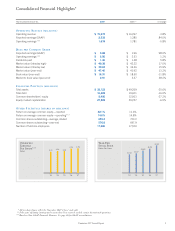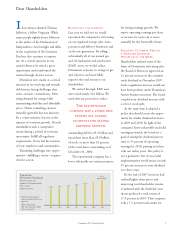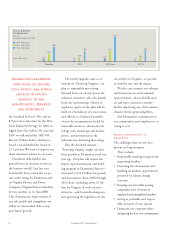Dominion Power 2007 Annual Report Download - page 11
Download and view the complete annual report
Please find page 11 of the 2007 Dominion Power annual report below. You can navigate through the pages in the report by either clicking on the pages listed below, or by using the keyword search tool below to find specific information within the annual report.
Dominion 2007 Annual Report 9
Protecting the
Environment & Building
on Business Opportunities
Presented by Climate
Change Concerns
Our customers depend on us to keep
their lights on, make them comfort-
able and power their businesses. We
aim to minimize the environmental
impact while serving their needs.
We understand that generating
electricity with fossil fuels can pollute
the air we breathe.
So we are taking the lead in
policymaking and in creating pro-
grams that benefit the environment.
TECHNOLOGY LEADERSHIP
Climate change dominates the
dialogue in the political realm. We
recognize, however, that while
we are not climatologists, regulation
of carbon emissions is coming.
Dominion is taking action.
Scientists cite carbon dioxide as
the principal culprit of global warm-
ing. When our industry develops the
technology to address carbon emis-
sions, it will have crossed an impor-
tant and necessary threshold.
Scientists are not there yet, and such
technology will not appear on its own.
That is why Dominion is investing in
opportunities to limit our carbon
emissions from coal-fired power sta-
tions—first by separating the carbon
dioxide from other air emissions and
then permanently storing, or
“sequestering,” the carbon dioxide.
To gain more insight into the
separation process, we are hosting a
large-scale, coal-to-natural-gas
demonstration project at our Brayton
Point Power Station in Massachusetts.
Project owner GreatPoint Energy of
Cambridge, Mass., will demonstrate
its technology to convert biomass,
coal and petroleum coke into sepa-
rate streams of natural gas and
sequestration-ready carbon dioxide.
As for the second challenge, a
$500,000 Dominion investment in
a Virginia Tech endeavor will study
sequestration of carbon dioxide
in unminable coal seams. This has
the added benefit of making
more natural gas available that can
be captured for use as fuel.
As the industry’s body of scientific
and technical knowledge matures,
and as rules and regulations evolve,
your company plans to look aggres-
sively for positive ways to contribute
and to find business opportunities.
Last year we formed an internal
task force—the Climate Change
Initiative—to carry through.
REDUCING OUR
CARBON FOOTPRINT
When it comes to limiting green-
house gas emissions, Dominion has
one of the best records in our peer
group, principally because we get
about 40 percent—twice the national
average—of our electricity from
carbon-free nuclear energy.
Although much remains unknown
about evolving climate change rules
and technology, one fact has become
clear to stakeholders: Nuclear
energy can and must play a role in
reducing carbon emissions.
FIRM COMMITMENT TO
RENEWABLE ENERGY
Renewable energy also has an impor-
tant role. Dominion plans to achieve
Virginia’s goal of 12 percent of
base-year electricity sales coming
from cost-effective renewable energy
sources by 2022. We also plan to
achieve North Carolina’s goal of
12.5 percent from renewable energy
sources and energy efficiency by 2021.
At year-end 2007 we had more
than 400 megawatts of generating
capacity from renewable sources.
This included the 83-megawatt
Pittsylvania Power Station in Hurt,
Va., one of the largest biomass gener-
ators on the East Coast, and 320
megawatts of hydropower. In early
2008 production began at a wind
farm project in West Virginia that we
jointly own with Shell WindEnergy.
CLIMATE CHANGE DOMINATES
THE DIALOGUE IN THE
POLITICAL REALM. WE
RECOGNIZE, HOWEVER, THAT
WHILE WE ARE NOT
CLIMATOLOGISTS, REGULA-
TION OF CARBON EMISSIONS
IS COMING. DOMINION IS
TAKING ACTION.
























